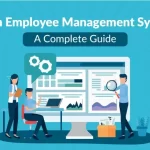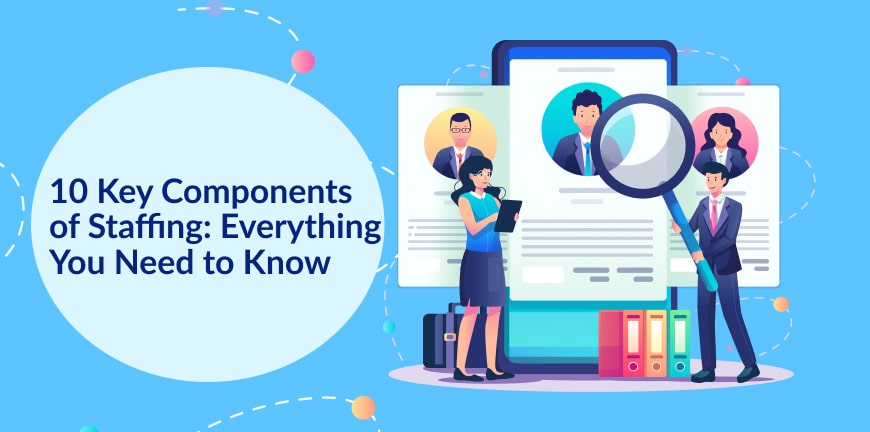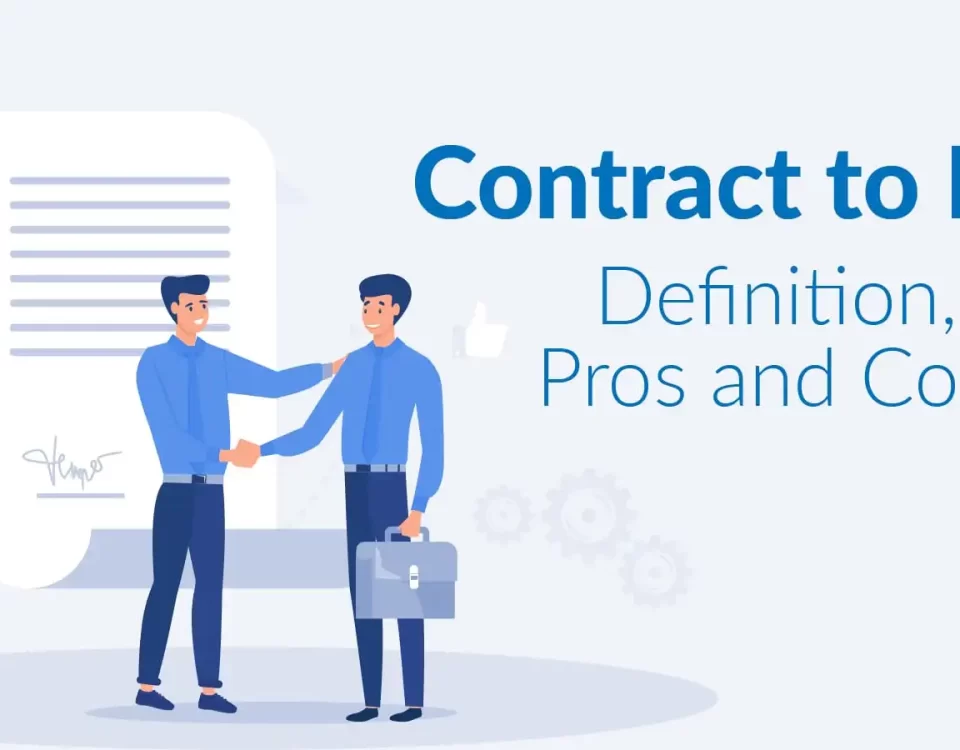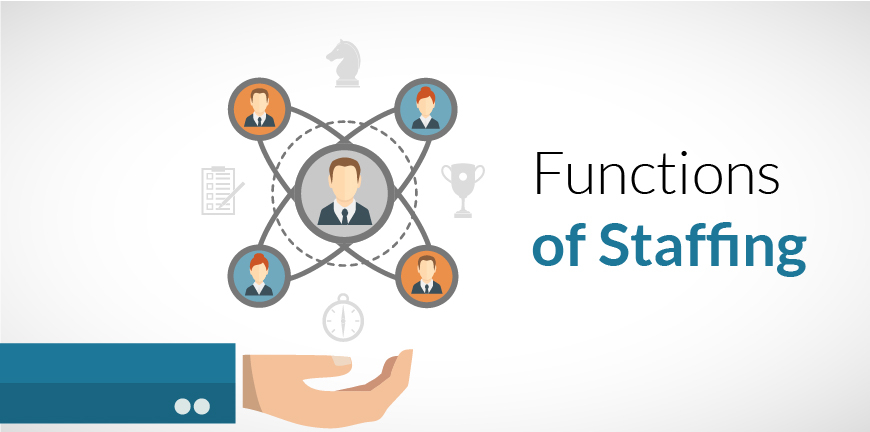
What Is Employee Training and Development? Importance, Types & Best Practices
28/04/2025
What Is an Employee Management System (EMS)? A Complete Guide
28/04/2025Staffing is a management function that focuses on hiring, training, and retaining talent for organizational roles. The staffing function encompasses activities like recruiting, selecting, promoting, and transferring the right person to fill a vacant position in the organization. To understand more about how staffing works, it is essential to know about the key components of staffing. Before we delve into the components of staffing process, let us look at what staffing essentially is.
What is Staffing? (Definition and meaning)
Staffing is the process of identifying, screening, and hiring the right individuals to fill open positions in an organization. Staffing is crucial function of management, and it involves matching candidates with the specific skills and knowledge required for roles, ultimately helping organizations create an effective and productive workforce.
Why are the Components of Staffing Important?
The components of staffing (manpower planning, recruitment and selection, placement and training, development, promotion, and appraisal) are important as it ensures that an organization has the right people in the right roles, leading to better productivity. Components of strategic staffing work together to build a skilled workforce.
1. Assessment of manpower needs
One of the main components of staffing, manpower planning helps determining the specific manpower needs of the business, which usually varies from season to season and is likely to change based on evolving economic conditions.
2. Placement and hiring
Detailed job descriptions are churned out to attract the best-qualified candidates. It ensures that applicants understand the requirements and responsibilities of the advertised open job positions and what the interviewers are looking for during the screening process.
3. Bringing employees up to speed with training and company culture
Effective staffing involves a full-spectrum introduction to a business’s corporate culture, including skills training as well as educating the employees regarding a company’s policies and procedures. Adding fresh staff members to an existing employee pool should include peer training and mentoring to maintain and bolster a company’s productivity.
4. Workforce Development
Post the hiring and training of an employee, they are paired with the right employees with the proper job responsibilities. This is achieved by assessing individual skills, talents, and experience levels. Employees, by now, have a full understanding of their duties. Ongoing training and development for new employees ensures efficient workplace productivity.
5. Boost Business Operations
Employees are provided with professional training and development opportunities. Job mentoring and job shadowing can encourage employees to learn more about the industry increasing their ability to contribute to the productivity and longevity of the organization.
6. Maintaining Workforce Longevity
Another major importance of one of the components of staffing process is that it can help businesses retain employees for a longer period, facilitating the development and nurturing a skilled, seasoned workforce. Employee incentive programs are a great way to boost employee morale and plays a key role in supporting long-term employment.
What are the 10 Key Components of Staffing?
Staffing function in an organization consists of several components. Here are 8 crucial components of staffing that you must know-
1. Manpower Planning
As the name suggests this is the phase where the organization and the staffing partner map out the exact workforce needs of the organization. It involves the analysis of current workforce and predicts the future manpower requirements to ensure that organization goals are met.
2. Recruitment
The recruitment process involves several tasks including identifying and sourcing candidates by using various sourcing channels like relevant job boards, networking, leveraging social media to get in touch with passive and active candidates. This helps match individuals with specific skills with the right roles to ensure better productivity.
3. Selection
Post the sourcing of candidates, the selection process begins wherein resumes of candidates are scrutinised and they are assessed based on their skills and experience, post which interviews are conducted to ensure the right candidates are selected.
4. Placement
The selected candidates are to be placed in the right roles to ensure the best use of their skills as well as lead to greater productivity of the organisation.
5. Orientation
Once the job role of a candidate is decided and the candidate is made aware of the duties and responsibilities to be carried out, an orientation program is conducted. The program helps the new employee get acquainted with the company culture, policies, and procedures.
6. Training and Development
Training is an essential part of the staffing process as it helps keep the employees updated on the way of work in an organisation. With the advances in technology and newer technologies come to life, companies must train employees help them understand the modern technology and make the best use of it.
Development refers to the opportunity of growth of the employees in the organisation. The organisation must provide ample opportunities for the development of the employees, without which the employees may become frustrated.
7. Promotion
Once the employee is settled in and has way past his probation period and is consistently performing well, around the one-year mark, in most cases, they are given a raise in salary or a better designation or both.
8. Transfer
Transfer is the process of shifting of an employee from one position to another in the organisation without any monetary benefit, or any increase in the responsibilities. This function needs to be evaluated from time to time.
9. Appraisal
Similar to the promotion stage, employees upon successful completion of their tasks over a period of time, based on several other factors like company budget, as well as how well the employee performed, they get an appraisal.
10. Determination of Remuneration
The remuneration of an employee is especially important for sustenance. It is regarded as one of the difficult functions to perform as there exists no tools which can accurately determine wages.
Staffing is more than just filling vacancies; it is a strategic process that ensures the right people are placed in the right roles at the right time. By focusing on its key components that include workforce planning, talent acquisition, selection, onboarding, training, and retention, organizations can build a strong foundation for long-term success.
A well-structured staffing strategy not only improves productivity and morale but also aligns talent management with business goals. In today’s competitive landscape, companies that invest in thoughtful, data-driven staffing practices will be better positioned to attract top talent, reduce turnover, and drive sustainable growth.
Frequently Asked Questions (FAQs)
1. What are the main components of staffing?
The main components of staffing include manpower planning, recruitment, selection, placement, training and development, performance appraisal, and compensation. These components work together to ensure that an organization has the right people in the right roles at the right time, capable of effectively achieving its goals.
2. What is the difference between staffing and recruitment?
Staffing is done to satisfy a temporary or contractual need which can transform into a permanent role. In recruitment, the goal is to hire for a permanent position. These days many companies are opting for contract staffing solutions as they prefer flexibility.
3. Why is workforce planning important in staffing?
Workforce planning is very important in staffing because it helps meet current client needs, retain employees for longer, enables better training initiatives, boosts employee engagement, and eventually, builds a better reputation for the company.
4. What tools help manage staffing effectively?
Several tools can help manage staffing effectively, including Applicant Tracking Systems (ATS), workforce management software, and performance management tools. These tools streamline the hiring process, manage employee records, and facilitate performance evaluations, leading to better workforce planning and decision-making.
5. What are the steps in the staffing process?
The staffing process involves several steps which include- determining manpower needs, recruitment of candidates, selection of candidates, orientation and placement, training and development and evaluation of performance, manager promotions, transfers and finally addressing of remunerations.
Contact Us For Business Enquiry

Kasthuri R
Kasthuri R is the Co-Founder & Executive Director at ALP Consulting, bringing over 23 years of experience in search, staffing, and HR consulting. She has been instrumental in driving ALP’s recruitment, employee leasing, and executive search practices across diverse industry verticals. With deep expertise in talent acquisition, HR strategy, and operational management, Kasthuri has built scalable, client-focused solutions that enhance workforce efficiency. Her strategic leadership continues to steer ALP Consulting toward innovation and excellence in people management.




